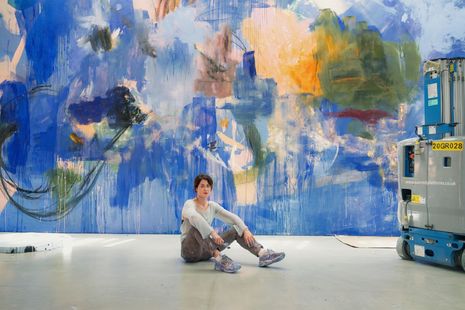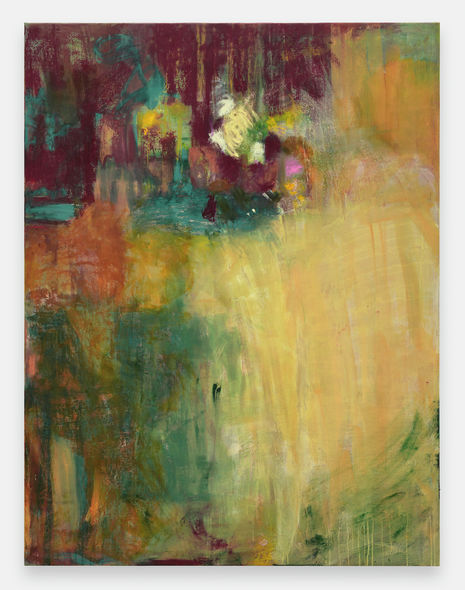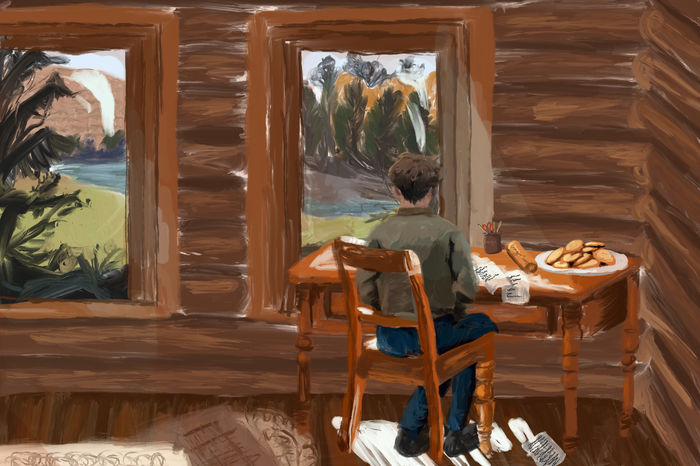Megan Rooney’s ‘Echoes and Hours’ absorbs space and mind
The Canadian artist’s Kettle’s Yard exhibition has its eyes open to the world’s unexpected beauty

To us enlightened moderns, abstract expressionism might seem a little passé: a relic of a more optimistic, naive 50s, the purview of wealthy New York bohemians. So it might come as a surprise that a major exhibition of contemporary abstract expressionist painting has been organised today. There might be refreshing scandal in being asked to lose oneself once again in a primordially aesthetic experience, to have one’s attention unexpectedly drawn to being, over object or concept. If so, perhaps this tells us something of how endless information flows have blurred our interface with the world, obscuring the value of the ineffable and tangible which are precisely the realm of aesthetic experience. The value of an exciting new exhibition at Kettle’s Yard, showcasing the abstract work of London-based multimedia artist Megan Rooney, lies in this reminder.
“The experience expands and contracts to fit the spaces one’s body passes through”
The exhibition’s title, ‘Echoes and Hours’, offers a way into its contemplative texture of sound and time, simply but intelligently displayed across its three main display spaces. Visitors are first invited into a rectangular gallery transformed by an abstract mural, illuminated by skylights. Rooney has directly painted over all four walls. Next, a more structured space forms the backdrop to what Rooney terms a “family” of seven human-sized canvases, painted specifically for the exhibition. Lastly, the more compact first-floor research space features small-scale drawings by Rooney, tentative assays in compositional approach. It’s a wonderful range of perceptual experience which expands and contracts to fit the spaces one’s body passes through.
No background knowledge is required — of Rooney’s comments on her artistic practice, her background in experimental dance, or even any awareness of the live performance (Spin Down Sky, staged by Rooney’s collaborators) which accompanied the mural — to feel the way the first room’s mural seizes and engages the body. Pictorially, a feedback loop of capricious intuition and careful, painterly response to its consequences accumulate in layers before erupting into poised, sweeping strokes on its surface. These strokes nakedly testify to gesture as they develop, interacting with each other like musical themes. They sit within gradations of texture: the rising up of patches of thickly-layered paint and the receding of more delicate, transparent splashes of colour. There is an affinity of method with Rooney’s sketches on paper upstairs — in which she starts with dark, violent strokes before layering on planes of colour, as if leaves on branches, observing their spontaneous interaction within the structure.
“An exhilarating counterpoint of freedom and constraint, of the real and the rational”
I was drawn towards narrative as I traced the mural across the walls: light emerging and retreating, seasons shifting, moods ebbing. Indeed, the mural’s dominant colours, hinting at nature (sand, waves, hazy skies), point in this direction. These are the most confident, attractive colours in the entire exhibition. Yet, this choreography tends towards asynchrony — after all, there is no ‘right order’ in which to view the mural, and moments in it resonate just as much across the walls as in linear sequence. Visitors’ bodies are caught in its intersecting vectors of movement. The paint’s play with the architecture itself transforms the way one experiences its traversal: one corner is dissolved by the continuity of vertical motifs across the walls, while another is highlighted. The result of all this is an exhilarating counterpoint of freedom and constraint, of the real and the rational, directly impacting upon the body as it passes through the volume of the space, weaving around and interacting with others — a movement which the work guides but does not restrict.

Rooney’s canvases in the next gallery, instead, arrest the gaze. We return to the repose of a more traditional viewing experience. So too, at times, does Rooney’s pictorial method. There are wonderful moments here: daring palettes, ruptures of stillness through violence. If the mural was about inhabiting space — these, which are stretched to Rooney’s own height — give a sense to inhabiting a body. Again, their colours evoke nature: vegetation, shade, rippling pools, suggesting a certain interpenetration of body and ecology. It’s fitting that Canadian-born Rooney finds herself at home in Britain, where the lessons of American abstract expressionism have always been tempered by a drive towards representation in its various forms — see John Hoyland, Robyn Denny, Anthony Caro. Still, I found her works most successful the further they travelled from familiar shapes, when they responded to nature rather than recording it, Monet-like. I am thinking of the searing pink field of The Way you Move, the violent, structuring tangle of oil crayon of On the Silver Minute.
Though the essential concerns of Rooney’s abstraction — space, the body, the artwork as a field of total experience — are old ones, she nonetheless tackles them afresh with a dancer’s daring and discipline. Some may ask if such a glance back — at art which asks us to suspend ourselves within aesthetic experience — is what we need in a time of urgent political flux. Abstraction seems to have little to say, directly and explicitly, to a surging far right, to a sea of death in Gaza, Syria, Sudan, Ukraine, and beyond. But to take such a position is perhaps to fundamentally miss the point. Abstraction is precisely not about saying — at its best, it is a rupture in the flows of information which have come to define the Internet age, and which have so often been weaponised.
The aesthetic space which Rooney’s art opens up — where one acquires certain awareness of being itself, a willingness to pause and be sensitive to the richness of experience the world affords us — is precisely the space where contemplation and critical thought becomes possible. It is open to everyone, in any place, at any time, with anyone else. And in this space, art like Rooney’s trains us to be alert to the surprise of the unexpected beauty the world furnishes, to be open to what is ineffably new and different.
‘Echoes and Hours’ runs until the 6th of October at Kettle’s Yard, Cambridge.
 News / Uni Scout and Guide Club affirms trans inclusion 12 December 2025
News / Uni Scout and Guide Club affirms trans inclusion 12 December 2025 News / Pembroke to convert listed office building into accom9 December 2025
News / Pembroke to convert listed office building into accom9 December 2025 News / Cambridge Vet School gets lifeline year to stay accredited28 November 2025
News / Cambridge Vet School gets lifeline year to stay accredited28 November 2025 Features / Searching for community in queer Cambridge10 December 2025
Features / Searching for community in queer Cambridge10 December 2025 News / Uni redundancy consultation ‘falls short of legal duties’, unions say6 December 2025
News / Uni redundancy consultation ‘falls short of legal duties’, unions say6 December 2025









